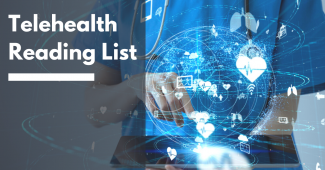Telehealth Reading List

Measures to reduce the risk of COVID-19 spreading through communities have forced healthcare professionals, who are used to working with patients face-to-face, to adjust their practice to avoid the spread of infection.
The WHO defines telehealth as the "delivery of health care services, where patients and providers are separated by distance. Telehealth uses technology for the exchange of information for the diagnosis and treatment of diseases and injuries, research and evaluation, and for the continuing education of health professionals”.
Here are some useful resources and articles that provide information about the forms of telehealth and ways that you can use it in practice.
- Cochrane’s vision is “a world of improved health where decisions about health and health care are informed by high-quality, relevant and up-to-date synthesized research evidence”. Part of quality health care is the ability to be flexible and responsive to situations. This Special Collection includes Cochrane Reviews on using telehealth to provide both patient and carer support.
- When working with people to reduce the harm from Noncommunicable diseases (NCD) it is vital that care is methodical, responsive and continuous. Unfortunately, as we all know, life can get in the way sometimes, and circumstances, often out with our control, can disrupt careful planning. Digital health can help reduce the negative impact of these disruptions. The Pan American Health Organization (PAHO) have put together a useful factsheet that provides some examples of how digital health tools have been applied to NCD management.
- The World Health Organisation recognises the importance of moving with the times and using the rapid advances in technology to inform health care practice. Digital technology, harnessed in the appropriate way, can reduce the health inequity that is present around the world. In the words of Dr Tedros Adhanom Ghebreyesus, Director-General, World Health Organization- Ultimately, digital technologies are not ends in themselves; they are vital tools to promote health, keep the world safe, and serve the vulnerable. This guideline provides recommendations for ways digital technology can be used as a tool alongside regular practice.
- Want a snap overview of some of the key issues in telehealth? The Addiction Technology Transfer Centre (ATTC) Network have developed a new Top Tips 8-part podcast series to support substance use disorder (SUD) treatment providers who are shifting to delivering care via digital methods.
- Addiction services around the world have had to change in response to the risks posed by COVID-19. For people seeking help for addiction-related issues, restricting face-to-face contact and connection with others can be a major obstacle on their road to recovery. The American Society of Addiction Medicine (ASAM) has put together useful guidelines to help healthcare providers working on the front line.
- Turning Point is a leading national addiction treatment, training and research centre in Australia. Turning Point could be considered experts in delivering telehealth care considering they have been running online and phone counselling services for over 30 years! This webinar provides some established telehealth tips, delivered by Turning Point clinicians with years of experience in this mode of service delivery.
- The transition to online care is not always smooth. For all professionals learning new skills there will be bumps along the way. In this qualitative study, the researchers interviewed clinicians who have started practising telemedicine, asking them to reflect on the benefits and downsides to delivering online support to people suffering from substance use disorders.
- This study, published in June 2021, aimed to explore the experiences of alcohol and other drug nurses transitioning to telehealth due to the COVID-19 pandemic. Participants reported challenges in transitioning to telehealth modalities. However, telehealth was a successful adjunct to existing practices for nurses working with consumers in regional or remote areas or where consumers preferred this method of service delivery.